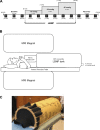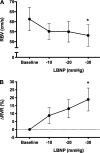Renal medullary oxygenation decreases with lower body negative pressure in healthy young adults
- PMID: 33211597
- PMCID: PMC7944934
- DOI: 10.1152/japplphysiol.00739.2019
Renal medullary oxygenation decreases with lower body negative pressure in healthy young adults
Abstract
One in three Americans suffer from kidney diseases such as chronic kidney disease, and one of the etiologies is suggested to be long-term renal hypoxia. Interestingly, sympathetic nervous system activation evokes a renal vasoconstrictor effect that may limit oxygen delivery to the kidney. In this report, we sought to determine if sympathetic activation evoked by lower body negative pressure (LBNP) would decrease cortical and medullary oxygenation in humans. LBNP was activated in a graded fashion (LBNP; -10, -20, and -30 mmHg), as renal oxygenation was measured (T2*, blood oxygen level dependent, BOLD MRI; n = 8). At a separate time, renal blood flow velocity (RBV) to the kidney was measured (n = 13) as LBNP was instituted. LBNP significantly reduced RBV (P = 0.041) at -30 mmHg of LBNP (Δ-8.17 ± 3.75 cm/s). Moreover, both renal medullary and cortical T2* were reduced with the graded LBNP application (main effect for the level of LBNP P = 0.0008). During recovery, RBV rapidly returned to baseline, whereas medullary T2* remained depressed into the first minute of recovery. In conclusion, sympathetic activation reduces renal blood flow and leads to a significant decrease in oxygenation in the renal cortex and medulla.NEW & NOTEWORTHY In healthy young adults, increased sympathetic activation induced by lower body negative pressure, led to a decrease in renal cortical and medullary oxygenation measured by T2*, a noninvasive magnetic resonance derived index of deoxyhemoglobin levels. In this study, we observed a significant decrease in renal cortical and medullary oxygenation with LBNP as well as an increase in renal vasoconstriction. We speculate that sympathetic renal vasoconstriction led to a significant reduction in tissue oxygenation by limiting oxygen delivery to the renal medulla.
Keywords: renal oxygenation; renal reflexes; sympathetic activation.
Conflict of interest statement
No conflicts of interest, financial or otherwise, are declared by the authors.
Figures





References
-
- GBD 2015 DALYs, HALE Collaborators. Global, regional, and national disability-adjusted life-years (DALYs) for 315 diseases and injuries and healthy life expectancy (HALE), 1990-2015: a systematic analysis for the Global Burden of Disease Study 2015. Lancet 388: 1603–1658, 2016. doi:10.1016/S0140-6736(16)31460-X. - DOI - PMC - PubMed
Publication types
MeSH terms
Grants and funding
LinkOut - more resources
Full Text Sources
Other Literature Sources

